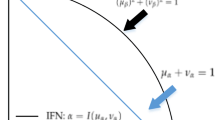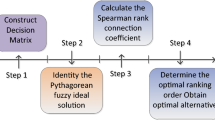Abstract
Pythagorean fuzzy sets (PFS) are extensively used to deal with ambiguity, vagueness and imprecision in real-world applications. In this article, interval type-2 Pythagorean fuzzy sets (IT2PFS) have been introduced that noticeably increases their flexibility as they are more effective in dealing with uncertainties. IT2PFS provide us with some extra degrees of freedom to characterize the vagueness and fuzziness of existent world. The novelty of the proposed scheme is to initiate an efficient approach for managing multiple criteria group decision-making (MCGDM) problems with partially known criterion weights modeled as interval type-2 trapezoidal Pythagorean fuzzy numbers (IT2TrPFN). Hybrid averaging (HA) operation based on weighted averaging (WA) and ordered weighted averaging (OWA) operators areemployed for constructing a collective decision environment by involving multiple decision-makers. Afterwards, an integrated optimization model based on a novel signed distance-based closeness coefficients (SDBCC) approach is established to approximate the importance weights of criteria and priority ranking of alternatives. The proposed scheme is employed for the selection of new site for building construction to demonstrate its feasibility and practicality. Moreover, a comparative investigation with some well-known approaches is conducted to verify the efficiency and usefulness of the proposed method
Similar content being viewed by others
References
Abdullah L, Goh P (2019) Decision making method based on Pythagorean fuzzy sets and its application to solid waste management. Complex Intell Syst 5:185–198
Akram M, Dudek WA (2019) Pythagorean Dombi fuzzy aggregation operators with application in multi criteria decision-making. Int J Intell Syst 34:3000–3019
Akram M, Dudek WA, Ilyas F (2019) Group decision-making based on Pythagorean fuzzy TOPSIS method. Int J Intell Syst 156:1–21
Akram M, Naz S, Davvaz B (2019) Simplified interval-valued Pythagorean fuzzy graphs with application. Complex Intell Syst 5:229–253
Atanassov KT (1986) Intuitionistic fuzzy sets. Fuzzy Set Syst 20:87–96
Atanassov KT (1989) More on intuitionistic fuzzy sets. Fuzzy Set Syst 33:37–46
Atanassov KT, Gargov G (1989) Interval valued intuitionistic fuzzy sets. Fuzzy Set Syst 31:343–349
Biswas P, Pramanik S, Giri BC (2016) Value and ambiguity index based ranking method of single-valued trapezoidal neutrosophic numbers and its application to multi-attribute decision making. Neutrosophic Sets Syst 12:127–138
Celik E, Gul M, Aydin B, Gumus AT (2015) A comprehensive review of multi criteria decision making approaches based on interval type-2 fuzzy sets. Knowl Based Syst 85:329–341
Chen TY (2018) An interval-valued Pythagorean fuzzy compromise approach with correlation-based closeness indices for multiple-criteria decision analysis of bridge construction methods. Complexity:1–29
Chen SM (1997) Interval-valued fuzzy hypergraph and fuzzy partition. IEEE Trans Syst Man Cybern Part B Cybern 27:725–733
Chen TY (2011) Signed distanced-based TOPSIS method for multiple criteria decision analysis based on generalized interval-valued fuzzy numbers. Int J Inf Technol Decis 10:1131–1159
Chen TY (2012) Multiple criteria group decision-making with generalized interval-valued fuzzy numbers based on signed distances and incomplete weights. Appl Math Model 36:3029–3052
Chen TY (2013) An interactive method for multiple criteria group decision analysis based on interval type-2 fuzzy sets and its application to medical decision making. Fuzzy Optim Decis Making 12:323–356
Chen TY (2013) A signed distance-based approach to importance assessment and multi-criteria group decision analysis based on interval type-2 fuzzy set. Knowl Inf Syst 35:193–231
Chen SM, Hong JA (2014) Fuzzy multiple attributes group decision-making based on ranking interval type-2 fuzzy sets and the TOPSIS method. IEEE Trans Syst Man Cybern Syst 44:1665–1673
Chen SM, Hsiao WH (2000) Bidirectional approximate reasoning for rule-based systems using interval-valued fuzzy sets. Fuzzy Sets Syst 113:185–203
Chen SM, Lee LW (2011) Fuzzy interpolative reasoning for sparse fuzzy rule-based systems based on interval type-2 fuzzy sets. Expert Syst Appl 38:9947–9957
Chen SM, Hsiao WH, Jong WT (1997) Bidirectional approximate reasoning based on interval-valued fuzzy sets. Fuzzy Sets Syst 91:339–353
Chen SM, Chang YC, Pan JS (2012) Fuzzy rules interpolation for sparse fuzzy rule-based systems based on interval type-2 Gaussian fuzzy sets and genetic algorithms. IEEE Trans Fuzzy Syst 21:412–425
Chen SM, Yang MW, Lee LW, Yang SW (2012) Fuzzy multiple attributes group decision-making based on ranking interval type-2 fuzzy sets. Expert Syst Appl 39:5295–5308
Dan S, Kar MB, Majumder S, Roy B, Kar S, Pamucar D (2019) Intuitionistic type-2 fuzzy set. Symmetry 11:01–18
Dubois D, Prade H (1980) Fuzzy sets and systems—theory and applications. Math Sci Eng 144:01–389
Garg H, Singh S (2018) A novel triangular interval type-2 intuitionistic fuzzy sets and their aggregation operators. Iran J Fuzzy Syst 15:69–93
Hwang CL, Yoon K (1981) Multiple attribute decision making—methods and applications
Kahraman C, Onar SC, Oztaysi B (2015) Fuzzy multi criteria decision-making: a literature review. Int J Comput Intell Syst 8:637–666
Kaliszewski I, Miroforidis J, Podkopaev D (2012) Interactive multiple criteria decision making based on preference driven evolutionary multi objective optimization with controllable accuracy. Eur J Oper Res 216:188–199
Katagiri H, Sakawa M (2011) Interactive multi objective fuzzy random programming through the level set-based probability model. Inf Sci 181:1641–1650
Li DF (2011) Closeness coefficient based nonlinear programming method for interval-valued intuitionistic fuzzy multi attribute decision making with incomplete preference information. Appl Soft Comput 11:3402–3418
Mahapatra GS, Roy TK (2013) Intuitionistic fuzzy number and its arithmetic operation with application on system failure. J Uncertain Syst 7:92–107
Mendel JM (2007) Advances in type-2 fuzzy sets and systems. Inf Sci 177:84–110
Mendel JM, John RB (2002) Type-2 fuzzy sets made simple. IEEE Trans Fuzzy Syst 10:117–127
Mendel JM, John RI, Liu FL (2006) Interval type-2 fuzzy logical systems made simple. IEEE Trans Fuzzy Syst 14:808–821
Own CM (2009) Switching between type-2 fuzzy sets and intuitionistic fuzzy sets; an application in medical diagnosis. Appl Intell 31:283–291
Park JH, Cho HJ, Kwun YC (2011) Extension of the VIKOR method for group decision making with interval-valued intuitionistic fuzzy information. Fuzzy Optim Decis Making 10:233–253
Peng X, Yang Y (2016) Fundamental properties of interval-valued Pythagorean fuzzy aggregation operators. Int J Intell Syst 31:447–487
Pramanik S, Mallick R (2019) TODIM strategy for MAGDM in trapezoidal neutrosophic number environment. Complex Intell Syst 5:379–389
Rahman K, Ali A, Khan MSA (2018) Some interval valued Pythagorean fuzzy weighted averaging aggregation operators and their application to multiple attribute decision making. J Math 50:113–129
Shakeel M, Aslam M, Amin NU, Jamil M (2020) Method of MAGDM based on pythagorean trapezoidal uncertain linguistic hesitant fuzzy aggregation operator with Einstein operations. J Intell Fuzzy Syst 38:2211–2230
Touqeer M, Salma J, Rida I (2020) A grey relational projection method for multi attribute decision making based on three trapezoidal fuzzy numbers. J Intell Fuzzy Syst 38:5957–5967
Touqeer M, Shaheen K, Rida I (2020) Evaluation model for manufacturing plants with linguistic information in terms of three trapezoidal fuzzy numbers. J Intell Fuzzy Syst 38:5969–5978
Touqeer M, Hafeez A, Misbah A (2020) Multi-attribute decision making using grey relational projection method based on interval type-2 trapezoidal fuzzy numbers. J Intell Fuzzy Syst 38:5979–5986
Turksen IB (1986) Interval valued fuzzy sets based on normal forms. Fuzzy Sets Syst 20:191–210
Wang W, Liu X, Qin Y (2012) Multi-attribute group decision making models under interval type-2 fuzzy environment. Knowl Based Syst 30:121–128
Weaver W (1948) Science and complexity. Am Sci 36:536–544
Wei GW, Wang HJ, Lin R (2011) Application of correlation coefficient to interval-valued intuitionistic fuzzy multiple attribute decision-making with incomplete weight information. Knowl Inf Syst 26:337–349
Xu Z (2005) An overview of methods of determining OWA weights. Int J Intell Syst 20:843–865
Xu Z (2010) An integrated model-based interactive approach to FMAGDM with incomplete preference information. Fuzzy Optim Decis Making 9:333–357
Xu Z, Yager RR (2006) Some geometric aggregation operators based on intuitionistic fuzzy sets. Int J Gener Syst 35:417–433
Yager RR (2013) Pythagorean fuzzy subsets. In: Proceedings of the 9th joint world congress on fuzzy systems and NAFIPS annual meeting. IFSA/NAFIPS, Edmonton, pp 57–61
M.S. Yang, Z. Hussain (2018) Fuzzy entropy for Pythagorean fuzzy sets with application to multi criterion decision making. Complexity:1–14
Yao JS, Wu K (2000) Ranking fuzzy numbers based on decomposition principle and signed distance. Fuzzy Set Syst 116:275–288
Yu D (2013) Intuitionistic trapezoidal fuzzy information aggregation methods and their applications to teaching quality evaluation. J Inf Comput Sci 10:1861–1869
Zadeh LA (1965) Fuzzy sets. Inf Control 8:338–353
Zadeh LA (1975) The concept of a linguistic variable and its application to approximate reasoning. Inf Sci 8:199–249
Zhang M, Zheng T, Zheng W, Zhou L (2020) Interval-valued Pythagorean hesitant fuzzy set and its application to multi attribute group decision-making. Complexity:1–26
Author information
Authors and Affiliations
Corresponding authors
Ethics declarations
Conflict of interest
There is no conflict of interest regarding this paper.
Additional information
Publisher's Note
Springer Nature remains neutral with regard to jurisdictional claims in published maps and institutional affiliations.
Rights and permissions
About this article
Cite this article
Touqeer, M., Umer, R., Ahmadian, A. et al. Signed distance-based closeness coefficients approach for solving inverse non-linear programming models for multiple criteria group decision-making using interval Type-2 pythagorean fuzzy numbers. Granul. Comput. 7, 881–901 (2022). https://doi.org/10.1007/s41066-021-00301-2
Received:
Accepted:
Published:
Issue Date:
DOI: https://doi.org/10.1007/s41066-021-00301-2




